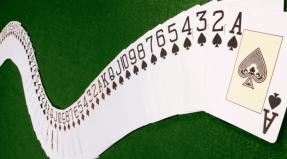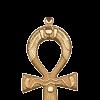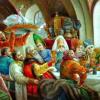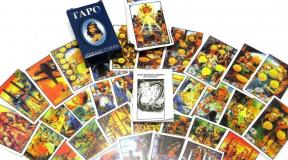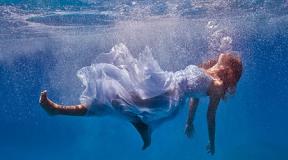Federico Garcia Lorca - biography, information, personal life. The saddest joy. Federico Garcia Lorca Lorca's poetry collections
When I die, bury me with a guitar in the river sand... These words Federico Garcia Lorca, one of the most famous poets in Spain, was not destined to come true. The talented writer, who sang Andalusia in his poems, lived only 38 years and died tragically in the first months of the Civil War. Until now, historians have not been able to accurately establish the circumstances of his death and the place of burial...

Lorca comes from the province of Granada, where he spent his childhood, and here his life was tragically cut short. Possessing extraordinary literary talent, Federico, in his youth, decides to devote his life to creativity. He travels a lot around Spain, getting acquainted with the folklore, traditions and customs of his country. At the age of twenty, the poet made a name for himself in the literary arena, publishing the collection “Impressions and Landscapes”; his debut was highly appreciated by his contemporaries.

The defining stage in Lorca's life were his university years spent in Madrid. Here the Andalusian meets the then very young artist Salvador Dali and the aspiring film director Luis Buñuel. Lorca works hard and productively, writes poems, and tries her hand at drama. By the time he graduated from university, Lorca had already earned literary fame and occupied a central position among avant-garde artists. He publishes several collections imbued with the romance of gypsy life, and a little later he travels to New York.

Lorca returned to Spain immediately after the establishment of the Second Spanish Republic. He went to visit his family in Granada, despite the fact that the political situation was tense to the limit. The poet stayed with a close friend, Luis Rosales, but this did not save him: Lorca was found, sentenced to death and the sentence was carried out. It is generally accepted that the poet was killed by Spanish Falangist fascists for political reasons. However, in recent years this hypothesis has been increasingly criticized...

Federico Lorca was apolitical by nature, in addition, some of his close friends were Falangists. So the assumption of a murder on political grounds can be challenged. There is much more reason to believe that Lorca’s death sentence was passed on by representatives of the influential clans of Granada, where Lorca’s father served as deputy mayor in the pre-war years. Lorca also personally annoyed the influential clans of Granada by caricaturing them in the play “The House of Bernarda Alba.”

It is worth mentioning one more important point. Justice in Granada was then administered by Ramon Ruiz Alonso, a parliamentarian famous for his cruelty. He was actively at odds with Luis Rosales, in whose house Lorca lived, so the death sentence of the poet was one of the ways for Alonso to take revenge, to accuse Rosales of harboring a particularly dangerous criminal spy.

Presumably, it was Ruiz Alonso who denounced Lorca, accusing him of spying for the Bolsheviks. For this charge, both Federico and Luis faced capital punishment - execution. Local authorities immediately assigned a battalion of militia, assembled from volunteer thugs, to punish the perpetrators. Lorca was soon arrested, his poet friends tried to seek help from the high command - General Franco. He made efforts to save the famous poet, but it was too late: Lorca was shot along with the other accused. This happened on August 18, 1936.

For a long time it was believed that Lorca was buried in a common grave with others shot in the Visnar ravine. In 2008, excavations were carried out, but the remains of the poet were not found. This gave reason to doubt the fact of his execution. According to one version, after the execution Lorca’s body was taken by his relatives, and they buried him in the family estate. According to another, the dying poet was saved by local residents, sent to the nearest monastery, and there he was attended by the abbess. At the same time, he lost his memory, could not speak clearly, and thus lived out his life. According to the most unlikely version, Lorca was rescued and sent to Argentina, where he lived in complete oblivion.
Andalusia, singer of her beauty. Look at the charm of its snow-white villages, it’s impossible not to fall in love with Spain!
Not much is usually said about Lorca: he was born on June 5, 1898 in the town of Fuente Vaqueros in Andalusia, at the age of 11 he moved with his family to Granada, he glorified the nature of these places in his poems, he did not study well at school, he was an impressionable, dreamy boy, he grew up He traveled a lot, became interested in poetry, entered the circle of avant-garde artists, wrote piercing poetry and prose, painted, and played music. He held left-wing views, for which he was shot by Franco’s fascists at the beginning of the Spanish Civil War. It’s even sad that such a large and deep life can be reduced to such a small and fleeting paragraph. It's even sadder that such a great and beautiful talent can be ruined with just one quick pull of the trigger...
Not everyone knows that Lorca was born into a very well-to-do family of a landowner who grew sugar cane, lived in a comfortable villa surrounded by picturesque nature, and his mother was a talented pianist. In his youth, Lorca was attracted to literature much less than music and theater. In general, he could have become a pianist, since it was the training of this skill that absorbed most of his time and energy.
He was inspired by Debussy, Chopin, Beethoven. A little later, Spanish folklore became his main Muse. This source of inspiration will also remain in literary creativity. Lorca began writing only after a tragic event that greatly influenced him - the death of his piano teacher. Then the young man wrote short essays - “Nocturne”, “Ballad”, “Sonata” - and set them to music. Even then, he began to gather around himself the artistic light of Granada - these were meetings in cafes, readings, conversations. A trip to the north of Spain, undertaken together with a professor at the university where he studied, resulted in a collection of poems, “Impressions and Landscapes,” and brought the talented 20-year-old boy his first fame. At the insistence of Professor Fernando de los Rios, who believed in Lorca's talent, the parents send their son to the progressive Oxford University in Madrid - the University Residencia de estudiantes - to study literature, law and philosophy.
Federico García quickly became a central figure in the artistic community of Madrid in the 1920s, where he came to study in 1919. At the university, he immediately made friends with the best of the best - Manuel de Falla and many other creative young people who would later become famous in the country. An acquaintance with Gregorio Martinez Sierra, director of the Eslava Theater, brought Lorca to the theater: admired by the young man’s talent, Sierra invited Lorca to write his first play, “The Witchcraft of the Butterfly.”
Ridicule from the public about the unusual plot - the love of a butterfly and a cockroach - determined Lorca's attitude towards the theater community. Disappointed by her superficial perception, he focuses on poetry.
Lorca was attracted to the themes of the Motherland, nature, love, and death. In a slightly surreal, enchanting manner, he glorified the surrounding reality and the realm of dreams. All this was reflected in the collections “Book of Poems”, “Poems about Cante Jondo”, “First Songs”, “Songs”.
The most famous collection of poems, “The Gypsy Romance” of 1928, was full of gypsy mythology in its fusion with the times of that time. Incredibly melodic, sonorous verses, stylized as ballads and poems of medieval times, still in use in the Andalusian countryside, became the basis for numerous romances. Until the end of his life, Lorca returned to the theme of “deep, fragile, trembling Andalusia,” hidden from the first glance at it.
However, success also had a negative side: Lorca suffered greatly from the label of “gypsy poet”, feeling the diminishment of his potential, the narrowing of his talent in this small definition. The depression was aggravated by the estrangement of his then best friend Salvador Dali, with whom, as you know, Lorca, who so poetically praised female beauty, was deeply in love, enormous suffering due to homosexuality, forced to be kept secret, and then a complete break with surrealist friends . At the same time, in 1929, Dali and Buñuel began collaborating on the film “Un Chien Andalou,” which Lorca saw as a mockery of him, and then Dali began an affair with his future wife and muse Gala. The family, concerned about Lorca's difficult mental state, insisted that he go to live in the United States for a year or two. Having left for New York, Garcia Lorca entered Columbia University, studied English, then moved to Vermont, then to Havana, Cuba. The 1931 book of poems “A Poet in New York” reflected the poet’s impressions of the year spent in the States, songs about the spirit of wandering, mixed with aching longing for his homeland. He made a sharp departure from the "folklorist" fame that had haunted him, exploring themes of alienation and isolation in a modern, materialistic society. He raised the same themes later, arguing, “great art depends on a vivid awareness of death, connection with the soil of the country and recognition of the limitations of the mind.”
The poet's last collection of poems was Sonnets of Dark Love, written in 1936, shortly before his execution, inspired by classic love sonnets of the 16th century.
Lorca also wrote prose, but the playwright's fame was later and not so bright. The first play after the unsuccessful debut of his youth was written only in 1927 - “Mariana Pineda” - and it was this play that Lorca called his first. Staged with the participation of Salvador Dali, it achieved great success during its premiere in Barcelona. In the USA in 1931, two plays “The Public” and “When Five Years Pass” were published, but the most famous, including for the Russian reader, appeared upon his return to Spain in the same year, during Lorca’s work as a director in a traveling student theater La Barraca ("The Showcase"), bringing theatrical art to poor Spanish neighborhoods. These are Blood Wedding, Yerma and The House of Bernarda Alba, full of contempt for the norms of traditional bourgeois society.
But Lorca's calling card is undoubtedly his poetry. Bright, deep, full of inner warm life poems left a hot mark in the hearts of his compatriots. They leave the same mark today.
Our talented poet was translated by equally talented individuals - M. Tsvetaeva, N. Aseev, V. Parnakh, A. Geleskul, Yunna Morits, N. Trauberg, N. Malinovskaya, B. Dubin, N. Vanhanen, K. M. Gusev and others.
It is worth noting that Lorca accompanied all his works with his own graphic drawings, an exhibition of which was held in Moscow at the Cervantes Institute in 2003.
Remembering Federico Garcia Lorca, “Evening Moscow” selected 7 of his famous poems:
1. BALLAD OF SEA WATER ("Book of Poems", 1921)
The sea laughs
at the edge of the lagoon.
Foam teeth
azure lips...
Girl with bronze breasts
Why are you looking with longing?
I sell water, my lord,
sea water.
A young man with dark blood,
What is it that keeps making noise in it?
This is water, my lord,
sea water.
Mother, why are your tears
flow like a salty river?
I cry with water, my lord,
sea water.
Heart, tell me, heart, -
where does this bitterness come from?
Too bitter, my lord,
sea water...
And the sea laughs
at the edge of the lagoon.
Foam teeth
azure lips.
(Translation by A. Geleskul)
2. GUITAR ("Poems about Cante Jondo", 1921)
Begins
Guitar cry.
Breaks
Cup of the morning.
Begins
Guitar cry.
Oh don't expect it from her
Silence,
Don't ask her
Silence!
Tirelessly
The guitar is crying
Like water through canals - it cries,
Like the winds over the snow, she cries,
Don't beg her
O silence!
So the sunset cries for the dawn,
So an arrow without a target cries,
So the hot sand cries
About the cool beauty of camellias,
This is how a bird says goodbye to life
Under threat of a snake's sting.
Oh guitar
Poor victim
Five agile daggers!
(Translation by M. Tsvetaeva)
3. MEMENTO ("Poems about cante jondo", 1921)
When I die
bury me with a guitar
in river sand.
When I die...
In the old orange grove,
in any flower.
When I die
I'll be a weather vane on the roof,
in the wind.
Quiet...
when I die!
(Translation by I. Tynyanova)
4. PRELUDE ("Songs", 1921-1924)
And the poplars go away
but their trace of the lake is bright.
And the poplars go away
but they leave us the wind.
And the wind will fall silent at night,
dressed in black crepe.
But the wind will leave an echo
floating down rivers.
And the world of fireflies will flood in -
and the past will drown in it.
And a tiny heart
will open in the palm of your hand.
(Translation by A. Geleskul)
5. Mute BOY ("Songs", 1921-1924)
(Translation by M. Samaev)
6. FAREWELL ("Songs", 1921-1924)
If I die -
do not close the balcony.
Children eat oranges.
(I can see this from the balcony.)
Reapers reap wheat.
(I hear this from the balcony.)
If I die -
do not close the balcony.
(Translation by A. Geleskul)
7. LITTLE VIENNAIAN WALTZ ("The Poet in New York", 1929-1930)
Ten girls are traveling to Vienna.
Death cries on the chest of the revelers.
There is a forest of stuffed pigeons there
and dawn in antique darkness.
There are halls with hundreds of windows
and behind them are clumps of trees...
Oh take this waltz
this lip-biting waltz.
This waltz, this waltz
full of death, prayer and wine,
where the wave plays like silk.
I love, I love, I love,
I love you there on the moon
and with a withered book in the window,
and in a secluded daisy nest,
and in that dance that the snail dreams of...
So please with warmth
this waltz with a broken wing.
There are three mirrors in the Vienna hall,
where they echo your lips.
Death plays the harpsichord
and the dancers are painted blue,
and brings shine to tears...
And over the city are the shadows of drunkards...
Oh take this waltz
on the hands of a dying dance.
I love, I love, my miracle,
I love you forever and everywhere
and on the roof, where I dream of my childhood,
and when you lift your eyelashes,
and behind them, in the silver cold, -
old Hungarian shepherd stars,
and lambs and lilies of ice...
Oh take this waltz
this waltz "I love forever."
I'll dance with you in Vienna
in the carnival dress of the river,
into a domino of water and shadow.
How dark are my reeds!..
And then a farewell tribute
I'll leave the echo of my breath
in photographs and weather vanes,
I'll lay kisses in front of the door -
and I will entrust your steps to the waves
waltz ribbons, violin and ashes.
(Translation by A. Geleskul)
Many say that in his poems Lorca predicted his violent death and burial in an unknown place. He actually wrote a lot about his death. He also foresaw the changes associated with the Civil War. And so it happened: friendly to the Republican regime, Lorca found himself the target of persecution during the Civil War that broke out in 1936. Despite the enormous danger associated with the concentration of Francoists in the south, the poet was very eager to get to his small homeland, Granada, to see the orange trees, to walk along the river bank... This step became fatal. On August 18, 1936, Lorca was arrested and the very next day he was shot in the mountains as a republican, and his books were banned until the death of General Franco.
Garcia Lorca Federico
Born: June 5, 1898.
Died: August 19, 1936.
Biography
Federico García Lorca: June 5, 1898 – August 19, 1936) was a Spanish poet and playwright, also known as a musician and graphic artist. The central figure of the “generation of ’27”, one of the brightest and most significant figures of Spanish culture of the 20th century. Killed at the beginning of the Spanish Civil War.
Lorca was born on June 5, 1898 in the town of Fuente Vaqueros in the Spanish province of Granada. The impressionable boy did not do well at school. In 1909 the family moved to Granada. In the 1910s, Federico was actively involved in the local artistic community. In 1914, Lorca began studying law, philosophy and literature at the University of Granada. Garcia Lorca travels a lot around the country. In 1918, Lorca published his first collection of poetry, Impresiones y paisajes (“Impressions and Landscapes”), which brought him, if not commercial success, then at least fame.
In 1919 Garcia Lorca arrived in Madrid. At the capital's university, he met Salvador Dali and Luis Buñuel, as well as Gregorio Martinez Sierra, director of the Eslava Theater. At the request of Martinez Sierra, Lorca wrote and staged his first play, El maleficio de la mariposa (The Witchcraft of the Butterfly) (1919-1920). Until 1928 he studied at the University of Madrid.
In subsequent years Garcia Lorca becomes a prominent figure among avant-garde artists. He has new poetry collections coming out, including Romancero gitano (“Gypsy Romancero”, 1928). In these poems, the poet, in his own words, “wanted to merge gypsy mythology with all of today’s everyday life.”
A year later, García Lorca left for New York, as a result of which new works soon appeared - the book of poems Poeta en Nueva York ("The Poet in New York", 1931), the plays El público ("The Public", 1931, 1936) and Así que pasen cinco años “When five years have passed” (1931).
The poet's return to Spain coincided with the fall of the Primo de Rivera regime and the establishment of the republic. In 1931, García Lorca was appointed director of the student theater La Barraca (Balagan). While working in the theater, Lorca created his most famous plays: Bodas de sangre ("Bloody Wedding"), Yerma ("Yerma") and La casa de Bernarda Alba ("The House of Bernarda Alba").
Before the start of the civil war, García Lorca left Madrid for Granada, although it was obvious that serious danger awaited him there: in the south of Spain the positions of the right were especially strong. On August 16, 1936, the Francoists arrested Garcia Lorca in the house of the Rosales brothers, and presumably the next day the poet was shot by order of Governor Valdez Guzman and secretly buried 2 km from Fuente Grande. After this, until the death of General Franco, García Lorca's books were banned in Spain. However, it should be noted that he maintained friendly relations with the leaders of the phalanx-HONS, José Antonio Primo de Rivera and Onesimo Redondo Ortega.
There is a version that the poet was not killed and simply went missing. In 2008, the granddaughter of a teacher who was shot along with Lorca demanded the exhumation of the bodies of the mass grave in which Lorca allegedly rested (under the law on the restoration of historical memory). The exhumation of this and 18 other mass graves was carried out on the orders of judge Baltasar Garzón, who acted on his own initiative, which resulted in his loss of office and criminal charges of abuse of power. No remains were found not only in the grave, but throughout the entire municipal district where, according to the official version, the tragedy unfolded. A more mythical version claims that the wounded poet was secretly transported to Argentina, but he no longer remembered his name or past.
Garcia Lorca's works have been translated into many languages; they were translated into Russian by M. Tsvetaeva (translated Lorca in the last days of her life), N. Aseev, V. Parnakh, A. Geleskul, Yunna Morits, N. Trauberg, N. Malinovskaya, B. Dubin, N. Vanhanen, K. M. Gusev and others.
Many admit that Lorca, at the end of the poem “The History and Cycle of Three Friends” (1930, collection “Poet in New York”), had a presentiment of the Civil War, his own death and the unknown location of his burial.
Prose
Impresiones u paisajes (Impressions and landscapes, 1918)
Collections of poetry|
Libro de poemas (Book of Poems, 1921)
Poema del cante jondo (Poems about cante jondo, 1921, ed. 1931)
Primeras canciones (First songs, 1921-1922, ed. 1936)
Canciones (Songs, 1921-1924, ed. 1927)
Oda a Salvador Dalí (Ode to Salvador Dalí, 1926)
Romancero gitano (Gypsy Romancero, ed. 1928)
Poeta en Nueva York (Poet in New York, 1929-1930, ed. 1940)
Llanto por Ignacio Sánchez Mejías (Lament for Ignacio Sánchez Mejías, 1935)
Seis poemas gallegos (Six poems in Galician, ed. 1935)
Diván del Tamarit (Tamarit's Divan, 1936, ed. 1938)
Sonetos del amor oscuro (Sonnets of Dark Love, 1936, ed. 1984)
Plays
Mariana Pineda (Mariana Pineda, 1927)
La zapatera prodigiosa (The Wonderful Shoemaker, 1930)
Retablillo de Don Cristóbal (Don Cristóbal's booth)
El público (The Public, 1930)
Así que pasen cinco años (When five years have passed, 1930)
Amor de don Perlimplín con Belisa en su jardín (The Love of Don Perlimplín, 1933)
Bodas de sangre (Bloody Wedding, 1933)
Yerma (Yerma, 1934)
Doña Rosita la soltera o el lenguaje de las flores (Doña Rosita, the Maiden, or the Language of Flowers), 1935)
La casa de Bernarda Alba (The House of Bernarda Alba, 1936)
In Russian translations|
Garcia Lorca F. Favorites. M., Goslitizdat, 1944
Garcia Lorca F. Selected lyrics. M., Goslitizdat, 1960
Garcia Lorca F. The saddest joy... Artistic journalism. M., Progress, 1987
Lorca in culture
Lorca's poems are an important element of Peter Lebedenko's novel "Red Wind", which explores the theme of the Spanish Civil War. The winner of the Federico Garcia Lorca Prize has been announced (Contraband, October 14, 2011)
In 1959, Joseph Brodsky dedicated the poem “The Definition of Poetry” to the memory of Garcia Lorca.
Ospovat L. S. Garcia Lorca. - M.: Mol. Guard, 1965. - 432 p. Circulation 115,000 copies. (The lives of wonderful people. Issue 16 (410).).
In 1970, American singer-songwriter Tim Buckley released the album Lorca, inspired by the works of the poet, with the composition of the same name.
In Spain, director Juan Antonio Bardem shot the biographical miniseries “Lorca, Death of a Poet” (1987).
Members of the Russian heavy metal band Aria in 1986, in order to facilitate the official submission of the program to the artistic council, attributed the lyrics of the song “Torero” (on the theme of bullfighting), actually written by Margarita Pushkina, to Garcia Lorca.
In 1994, Alexander Yakovlevich Rosenbaum’s album “Sluggish Schizophrenia” was released, in which one of the songs “Federico Garcia Lorca” is dedicated to the poet.
In 1996, Alexander Gradsky’s CD “Golden Old Things” was released, in which one of the songs (“Spain”, music: A. Gradsky, lyrics: N. Aseev) was dedicated to the memory of Federico Garcia Lorca.
In 2003, based on the novel of the same name by Nadal Prize winner Fernando Marias (published in Russian translation under the title “Magic Light”), the film “Divine Light” was shot, which received an award at the Moscow Film Festival. He talks about Lorca’s “second life,” as if he had not died but, having lost his memory, wandered along the roads of Granada.
In 2005, Garcia Lorca's poem "De profundis" was painted on the wall of a building in the center of Leiden (Netherlands). It became the last in a series of one hundred and one similar monuments to world-famous poets as part of the cultural project “Wall poems”.
In 2008, dir. Paul Morrison directed a film dedicated to the relationship between F. Garcia Lorca and S. Dali - “Echoes of the Past” (“Salvador Dali: Love. Art. Betrayal”).
In 2015, the science fiction series “Ministry of Time” began airing in Spain. The 8th episode of the 1st season is dedicated to the events that took place at the University of Madrid in 1924; One of the main characters in the series is Federico García Lorca.
Mentioned in the song of the DDT group “Life is beautiful” from the album “Transparent” (“Do you remember how you loved Lorca Garcia”).
Miscellaneous
In the late 1980s, thanks to the research of biographer Ian Gibson, Garcia Lorca's homosexuality became known. His lover in the last years of his life was the journalist and critic Juan Ramirez de Lucas, to whom the poet dedicated “Sonnets of Dark Love.”
In the fighting film Undisputed 3, the Colombian fighter often holds a book of Federico Garcia Lorca's poem in his hands.
On May 2, 2003, 40 original drawings by Lorca and his personal belongings were exhibited for the first time at the Cervantes Institute in Moscow. All exhibits belong to the García Lorca Foundation, which is run by members of the poet’s family. The exhibition was called “The World of Federico García Lorca.”
Featured on a 1989 Albanian postage stamp.
Featured on the 1993 Cuban 1 and 10 Peso coins.
Killed at the start of the Spanish Civil War.
Biography
Lorca was born on June 5, 1898 in the town of Fuente Vaqueros in the Spanish province of Granada. The impressionable boy did not do well at school. In the city the family moved to Granada. In the 1910s, Federico was actively involved in the local artistic community. In 1914, Lorca began studying law, philosophy and literature at the University of Granada. Garcia Lorca travels a lot around the country. Lorca's first collection of poetry comes out in the city, Impressions and paisages(“Impressions and Landscapes”), which brought him, if not commercial success, then at least fame.
In Garcia Lorca arrives in Madrid. At the capital's university, he met Salvador Dali and Luis Buñuel, as well as Gregorio Martinez Sierra, director of the Eslava Theater. At the request of Martinez Sierra Lorca writes his first play El maleficio de la mariposa(“The Witchcraft of the Butterfly”) and staged it (-1920). Until 1928 he studied at the University of Madrid.
In subsequent years, García Lorca became a prominent figure among avant-garde artists. He has new poetry collections coming out, including Romancero gitano(“Gypsy Romancero”, 1928). In these poems, the poet, in his own words, “wanted to merge gypsy mythology with all of today’s everyday life.”
A year later, Garcia Lorca leaves for New York, as a result of which new works soon appear - a book of poems Poeta en Nueva York("The Poet in New York", 1931), plays El publico(“The Public”, 1936) and “When Five Years Gone” (1931).
The poet's return to Spain coincided with the fall of the Primo de Rivera regime and the establishment of the republic. In 1931, García Lorca was appointed director of the student theater La Barraca (Balagan). While working in the theater, Lorca created his most famous plays: Bodas de sangre("Bloody Wedding") Yerma("Yerma") and La casa de Bernarda Alba(“House of Bernarda Alba”).
Before the start of the civil war, García Lorca left Madrid for Granada, although it was obvious that serious danger awaited him there: in the south of Spain the positions of the right were especially strong. On August 16, 1936, the Francoists arrested García Lorca in the house of the Rosales brothers, and presumably the next day the poet was shot by order of Governor Valdez Guzmán and secretly buried 2 km from Fuente Grande. After this, until the death of General Franco, García Lorca's books were banned in Spain. However, it should be noted that he maintained friendly relations with the leaders of the phalanx-HONS, José Antonio Primo de Rivera and Onesimo Redondo Ortega.
There is a version that the poet was not killed and simply went missing. In 2008, the granddaughter of a teacher who was shot along with Lorca demanded the exhumation of the bodies of the mass grave in which Lorca allegedly rested (under the law on the restoration of historical memory). The exhumation of this and 18 other mass graves was carried out by order of judge Baltasar Garzón, who acted on his own initiative, which resulted in his loss of office and criminal charges of abuse of power. No remains were found not only in the grave, but throughout the entire municipal district where, according to the official version, the tragedy unfolded. A more mythical version claims that the wounded poet was secretly transported to Argentina, but he no longer remembered his name or past.
Garcia Lorca's works have been translated into many languages; they were translated into Russian by M. Tsvetaeva (translated Lorca in the last days of her life), N. Aseev, V. Parnakh, A. Geleskul, Yunna Morits, N. Trauberg, N. Malinovskaya, B. Dubin, N. Vanhanen, K. M. Gusev and others.
Many admit that Lorca, at the end of the poem “The History and Cycle of Three Friends” (1930, collection “Poet in New York”), had a presentiment of the Civil War, his own death and the unknown location of his burial.
Works
Monument to Lorca in Madrid (Plaza de Santa Ana)
Prose
- Impresiones y paisajes (Impressions and landscapes, 1918)
Poetry collections
- Libro de poemas (Book of Poems, 1921)
- Poema del cante jondo (Poems about cante jondo, 1921, ed. 1931)
- Primeras canciones (First songs, 1921-1922, ed. 1936)
- Canciones (Songs, 1921-1924, ed. 1927)
- Oda a Salvador Dalí (Ode to Salvador Dalí, 1926)
- Romancero gitano (Gypsy Romancero, ed. 1928)
- Poeta en Nueva York (Poet in New York, 1929-1930, ed. 1940)
- Llanto por Ignacio Sánchez Mejías (Lament for Ignacio Sánchez Mejías, 1935)
- Seis poemas gallegos (Six poems in Galician, ed. 1935)
- Diván del Tamarit (Tamarit's Divan, 1936, ed. 1938)
- Sonetos del amor oscuro (Sonnets of Dark Love, 1936, ed. 1984)
Plays
- Mariana Pineda (Mariana Pineda, )
- La zapatera prodigiosa (The wonderful shoemaker)
- Retablillo de Don Cristóbal (Don Cristóbal's booth)
- El público (The Public, 1930)
- Así que pasen cinco años (When five years have passed, 1930)
- Amor de don Perlimplín con Belisa en su jardín (Love of Don Perlimplín, )
- Bodas de sangre (Bloody Wedding)
- Yerma (Yerma, )
- Doña Rosita la soltera o el lenguaje de las flores (Doña Rosita, the Maiden, or the Language of Flowers)
- La casa de Bernarda Alba (Bernarda Alba's House, )
In Russian translations
- Garcia Lorca F. Favorites. M., Goslitizdat, 1944
- Garcia Lorca F. Selected lyrics. M., Goslitizdat, 1960
- Garcia Lorca F. The saddest joy... Artistic journalism. M., Progress, 1987
Lorca in culture
- Since 2003, the Federico García Lorca International Poetry Prize has been awarded annually in Granada.
- In Spain, director Juan Antonio Bardem shot the biographical miniseries “Lorca, Death of a Poet” (1987).
- Members of the Russian heavy metal band Aria in 1986, in order to facilitate the official submission of the program to the artistic council, attributed the lyrics to the song “Torero” (on the theme (published in translation into Russian under the name “Magic Light”) the film “Divine Light” was made, which received award “Echoes of the Past” (“Salvador Dali: Love. Art. Betrayal”).
- In 2015, the science fiction series “Ministry of Time” began airing in Spain. The 8th episode of the 1st season is dedicated to the events that took place at the University of Madrid in 1924; One of the main characters in the series is Federico García Lorca.
Miscellaneous
- In the late 1980s, thanks to the research of biographer Ian Gibson, Garcia Lorca's homosexuality became known. His lover in the last years of his life was the journalist and critic Juan Ramirez de Lucas, to whom the poet dedicated "Sonnets of Dark Love"
- Featured on a 1989 Albanian postage stamp.
Biography
In the Soviet Union, Lorca was one of the most published foreign poets. This is explained by the fact that the poet was shot by the Nazis in 1936 - and this shooting had a huge resonance throughout the world. It was some kind of significant execution, with it, as it were, a bloody fascist massacre began in the world, and anti-fascist forces began to unite. Then the words of the Chilean poet Pablo Neruda were heard loudly: “The poet is dead. And what a poet! Simple-minded and artistic, equally not alien to the cosmic and provincial, unusually musical, a magnificent mime, timid and superstitious, tormented and cheerful, he seemed to have absorbed all the ages of Spain, the whole flower of folk talent, everything that the Arab-Andalusian culture gave " .
The second reason for the success of Lorca’s poetry among Russian readers is that in general such vividly emotional Spanish poetry is close to the soul of the Russian person. They say that Russians and Spaniards have long sympathized with each other, that there is something in common in the mentality of both peoples. May be. At least, Lorca’s poetry is well known among us, our bards have written many songs based on his poems, our artists have painted many canvases on Lorca’s Spanish themes, and the St. Petersburg painter A. A. Mylnikov for his triptych “Bullfight. Crucifixion. Garcia Lorca" received the State Prize, and this bright work now adorns one of the halls of the Tretyakov Gallery.
Federico García Lorca was born on June 5, 1898 in the Andalusian village of Fuente Vaqueros, which means the Source of the Shepherds. His father was a wealthy tenant. Mother is a school teacher. The boy's first childhood impressions were related to music. It all started with songs that my father sang with a guitar. Mom played the piano. As a child, Lorca heard a lot of cries, romances, lullabies, sung by ordinary people of Andalusia, modest maids and peasants.
At the age of six, the future poet and playwright was amazed by a puppet theater performance.
After the family moves to Granada, which Lorca will consider throughout his life as the history, poetry and pure beauty of Spain, the young man begins a rapid process of maturation as a poet; he spends days wandering through the ancient legendary streets, through the halls of the Alhambra, and through Marianna Pineda Square. . . At the University of Granada, Federico became interested in the poetry of Ruben Dario, Manuel Machado, Juan Ramon Jimenez, and began to compose himself.
In the summer of 1917, Federico and a group of students traveled around Galicia, Castile, and Leon. He listened, observed, remembered and searched for his own way of expression, his voice. From his travel diaries in Spain his first collection was born, not of poetry, but of prose. He called the book “Impressions and Pictures.” The book was published with drawings by the author.
Then he wrote the play “The Evil Spell of the Butterfly,” the production of which failed at the Eslava Theater in Madrid.
In 1919, Lorca was enrolled in the Madrid Student Residence, it was a privileged educational institution, something like the Spanish Oxford. Here he found himself in a whirlwind of debates about modern art, here he met Salvador Dali, Jose Guillen, Rafael Alberti, Paul Valery, Albert Einstein, Le Carbusier came here to give lectures, and prominent Spanish writers of the older generation Antonio Machado and Miguel de Unamuno often visited.
In 1921, the first book of poems was published, which was called “The Book of Poems.” There was still a sense of apprenticeship in her, but something deeply original and independent was already emerging. Originality lay in the poet’s combination of book and spontaneous folk culture. Lorca wrote poems like songs - for voice and hearing. He even valued his poems in published form less than in oral performance; he attached great importance to gesture and sound associations.
In 1923, the poet passed the exam for the degree of licentiate in law. The father was very pleased with his son, but by this time the son himself attached much greater importance, for example, to the Andalusian folk song festival, which he started with the famous composer Manuel de Falla. They traveled around Spain together and looked for and invited cantors to the festival - performers of the rarest and most ancient type of primitive songs in Europe, “cante jondo”. Then Lorca will publish a book of poems, Poems about Cante Jondo. He considered this type of primordial songs to be “deep singing” and in his poems he also strived for “deep singing.”
Begins
crying guitar.
Breaks
morning cup
Begins
crying guitar.
Oh don't expect from her
silence,
don't ask her for silence!
Tirelessly
the guitar is crying,
like water through the canals - it cries,
like the winds over the snow - crying,
don't beg her to remain silent!
So the sunset cries for the dawn,
This is how an arrow without a target cries,
so the hot sand cries
about the cool beauty of camellias.
This is how a bird says goodbye to life
under the threat of a snake's sting.
Oh guitar
poor victim
five nimble daggers!
This poem - “Guitar” - was translated into Russian by Marina Tsvetaeva.
Lorca's fame was brought to him by the book "The Gypsy Romance", published in 1928. Almost all the romances in this book were known to readers from lists that were passed around the country from hand to hand, passed down from memory, read and sung in the most remote corners of Spain.
This was the case, for example, with Yesenin’s poems in Russia, people had not yet even seen his books, but “You are still alive, my old lady” or “You are my fallen maple” were sung everywhere and by everyone. Lorca’s “Unfaithful Wife” from “A Gypsy Romancero” was also widely known, for example.
A CHEATING WIFE
And at midnight to the edge of the valley
I stole someone else's wife,
I thought she was innocent...
It was the night of Sant'Iago,
and, as if they were happy about the agreement,
the lights in the area went out
and the cicadas began to flicker.
I touched sleepy breasts,
passing the last alley,
and they opened hotly
brushes of night jasmines.
And the skirts, rustling with starch,
my ears were shaking,
like silk curtains,
shredded by knives.
Growing into the moonless darkness,
the trees grumbled dully,
and distant dog barking
the district was chasing us...
Behind the blue blackberries
at the reed stretch
I slammed into white sand
her resin braids.
I pulled off the silk tie.
She scattered her outfit.
I took off my belt and holster,
she is four corsages.
Her jasmine skin
glowed like warm pearls,
softer than moonlight,
when he slides across the glass.
And her hips were darting,
like caught trout,
then they were frozen by the moon cold,
then they burned with white fire.
And the best in the world dear
until the first morning bird
I was rushed this night
satin mare...
To the one who is considered a man,
It’s not appropriate not to be modest,
I won't repeat it
the words she whispered.
In grains of sand and kisses
she left at dawn.
Daggers of Club Lilies
the wind was chopping in pursuit.
I behaved the way I should
gypsies until the hour of death.
I gave her a chest as a keepsake
and did not meet again,
remembering the deception of that night
at the edge of the river valley, -
she was married after all,
and she swore to me that she was innocent.
Lorca wrote many wonderful poems, many plays, brilliant articles. He will also visit America, become interested in surrealism, then return to the ancient Arabic tradition - he will write qasidas, from which the “Divan Tamarita” will be formed. Divan means collection in Arabic. In a word, the poet absorbed a lot. But at the same time he remained a truly national Spanish poet, because he melted everything he acquired in himself and turned it into a Spanish song, most often it was a bitter, tragic song about the fate of a Spanish woman. In Lorca, almost all women are sad, a woman for him is a symbol of loneliness, they burn in love.
There is a lot of death in his poems, death in the form of a rider on a horse, “sleepless horseman.”
Lorca wrote his “Farewell” early, in 1924.
If I die -
do not close the balcony,
Children eat oranges.
(I can see this from the balcony.)
Reapers reap wheat.
(I hear this from the balcony.)
If I die -
do not close the balcony.
This short poem expressed all the main things that inspire his work: folk life, his beloved Spain, the openness of the poet’s soul and the readiness to accept death, having known happiness in life. ..
He was a very passionate poet. He himself said “What poetry does not tolerate under any guise is indifference. Indifference is the throne of Satan, and yet it is precisely this that speaks at all crossroads in the clownish garb of complacency and culture.” And he also said: “The poet has one mission: to animate in the literal sense - to give a soul.”
Garcia Lorca put his whole soul into his songs, which everyone in Spain knows.
Finally, a few more poems by the great Spanish poet.
SONG
If you hear crying
bitter oleander through the silence,
what will you do, my love
I'll sigh.
If you see that you
the light calls with it, leaving,
what will you do, my love
I will remember the sea.
If under the olive trees in the garden
I will tell you “I love you”, -
what will you do, my love-
I'll stab myself.
BLACK MOONS
Black moons above the shore,
and the sea in agate light.
They're crying after me
my unborn children.
Father, don’t leave us, stay!
The youngest has his hands folded...
My pupils are streaming.
Roosters are crowing around.
And the sea turns to stone in the distance
under the mask of wavy laughter.
Father, don't leave us!..
And the echo crumbled like a rose.
QUIET WATERS
My eyes to the bottom
float the river...
With sadness and love
float the river...
(Heart counts down
rest hours.)
Dry herbs floating
road to the mouth...
Light and majestic
road to the mouth...
(Isn't it time to go,
asked the heart with sadness.)
FAREWELL
I say goodbye
at the edge of the road.
Guessing the native
I hurried to the distant cry -
and they cried over me.
I say goodbye at the edge of the road.
Another, unearthly road
I'll leave the crossroads
awaken a sad memory
about a dark moment.
I won't become a wet shiver
stars at sunrise.
I returned to the white grove
silent melodies.


